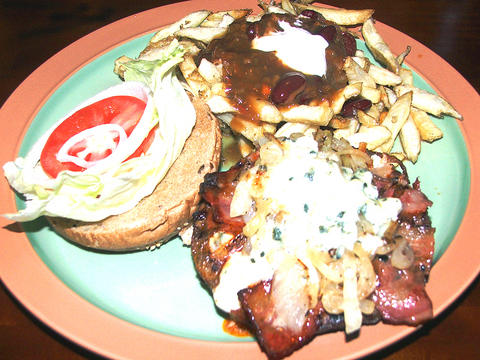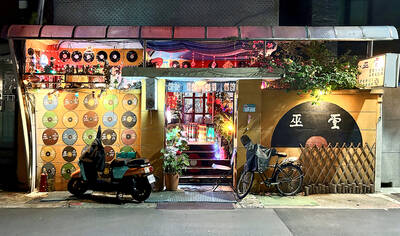Andrew Lunman had a dream. Like many long-term foreign residents who have grown tired of teaching, he wanted to open his own restaurant. So he started Bongos, a low-key North American-style place in Gonguan. That did pretty well, so last year he opened Coda, a slightly more upscale Italian-American restaurant in the same neighborhood. Business there hasn't been bad either. So now Lunman has taken on a new project and is helping Joe Hodgson with Hodgson's new gourmet burger restaurant, Forker's, which opened last month in an alley behind the California Fitness Center on Zhongxiao East Road.
The concept at Forkers is simple. Lure customers with a basic burger that, at NT$190 with a drink and two sides, doesn't seem much more expensive than a combo meal at a fast food restaurant. Then present said customer with a very long list of optional upgrades. How about a burger with mushrooms and cheese for NT$60 more, and Tex-Mex fajita fries for NT$40? Sounds reasonable. Only NT$30 extra for endless drink refills? Seems like a good deal. And why not drop another NT$80 on a deluxe patty made from imported Kobe beef? (The latter option will be available at the beginning of next year, Lunman says.)
It's hard to resist so many temptations. A few NT dollars here, a few NT dollars there, and soon you're spending a lot more than you originally intended. Not that you'll mind. Though the core products more than hold their own against the competition - the patties are well-seasoned and beefy, the fries are cut from unpeeled russets, not frozen potatoes - the upgrades are phenomenal.

PHOTO: RON BROWNLOW, TAIPEI TIMES
Take the monster burger (NT$270), for example. Served with red hot sauce, blue cheese, fried onions, bacon, lettuce, tomatoes and ranch dressing, it is the kind of Dagwood sandwich you probably dreamed of making one day when you were really, really hungry. In the wrong hands, it would be a mess, but Forkers gets the combination just right. Each bite delivers a burst of distinct flavors - tangy blue cheese, spicy hot sauce, creamy ranch dressing - and the burger holds itself together neatly until the end. The bun doesn't break, the patty doesn't separate itself from the toppings, and the sauce don't ooze out and get all over your hands.
The menu lists more than 30 souped-up burgers like this one. And then there's the restaurant's signature dishes, which are called, of course, the forkers. These are open-faced hamburgers topped with things like poutine or spaghetti.
On Sunday, Feb. 3, 2008, everything at Forkers will be priced 25 percent off.

The Lee (李) family migrated to Taiwan in trickles many decades ago. Born in Myanmar, they are ethnically Chinese and their first language is Yunnanese, from China’s Yunnan Province. Today, they run a cozy little restaurant in Taipei’s student stomping ground, near National Taiwan University (NTU), serving up a daily pre-selected menu that pays homage to their blended Yunnan-Burmese heritage, where lemongrass and curry leaves sit beside century egg and pickled woodear mushrooms. Wu Yun (巫雲) is more akin to a family home that has set up tables and chairs and welcomed strangers to cozy up and share a meal

Dec. 8 to Dec. 14 Chang-Lee Te-ho (張李德和) had her father’s words etched into stone as her personal motto: “Even as a woman, you should master at least one art.” She went on to excel in seven — classical poetry, lyrical poetry, calligraphy, painting, music, chess and embroidery — and was also a respected educator, charity organizer and provincial assemblywoman. Among her many monikers was “Poetry Mother” (詩媽). While her father Lee Chao-yuan’s (李昭元) phrasing reflected the social norms of the 1890s, it was relatively progressive for the time. He personally taught Chang-Lee the Chinese classics until she entered public

Last week writer Wei Lingling (魏玲靈) unloaded a remarkably conventional pro-China column in the Wall Street Journal (“From Bush’s Rebuke to Trump’s Whisper: Navigating a Geopolitical Flashpoint,” Dec 2, 2025). Wei alleged that in a phone call, US President Donald Trump advised Japanese Prime Minister Sanae Takaichi not to provoke the People’s Republic of China (PRC) over Taiwan. Wei’s claim was categorically denied by Japanese government sources. Trump’s call to Takaichi, Wei said, was just like the moment in 2003 when former US president George Bush stood next to former Chinese premier Wen Jia-bao (溫家寶) and criticized former president Chen

President William Lai (賴清德) has proposed a NT$1.25 trillion (US$40 billion) special eight-year budget that intends to bolster Taiwan’s national defense, with a “T-Dome” plan to create “an unassailable Taiwan, safeguarded by innovation and technology” as its centerpiece. This is an interesting test for the Chinese Nationalist Party (KMT), and how they handle it will likely provide some answers as to where the party currently stands. Naturally, the Lai administration and his Democratic Progressive Party (DPP) are for it, as are the Americans. The Chinese Communist Party (CCP) is not. The interests and agendas of those three are clear, but